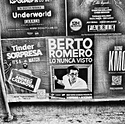aconbere
Subscriber
I haven’t seriously thought about chemistry in an academic way since high school some 20 odd years ago. If I wanted to pick up enough chemistry to understand what the heck a reduction oxidation reaction is and how that’s involved with iron in siderotypes (as an example). What are my best avenues?
I feel like there’s gotta be an “Introduction to photographic chemistry” from the 60s that’s floating around? Or should I just grab a chemistry 101 text book?
I feel like there’s gotta be an “Introduction to photographic chemistry” from the 60s that’s floating around? Or should I just grab a chemistry 101 text book?






